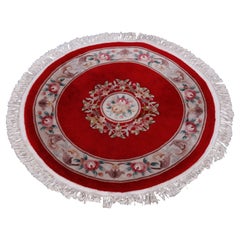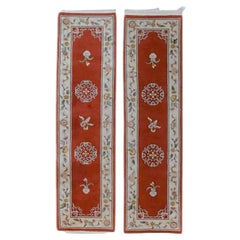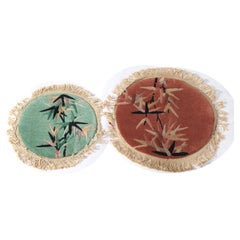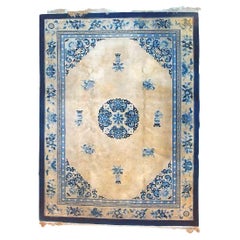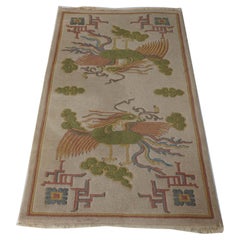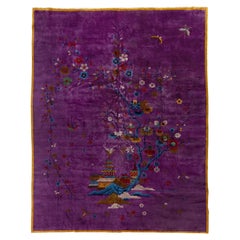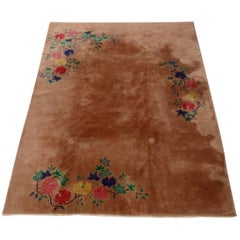Antique Revival Chinese and East Asian Rugs
to
7
Width
to
Length
to
8
8
2
3
8
7
1
8
8
8
8
3
1
1
1
1
Chinese Nichols Round Oriental Wool Rug, C1940
By Nichols
Located in Big Flats, NY
A Chinese Nichols oriental rug offers wool construction in circular form with central floral medallion on red ground, C1940
Measures - 55''H x 55'...
Category
Mid-20th Century Chinese Chinese and East Asian Rugs
Materials
Wool
$440 Sale Price
20% Off
Matching Pair of Chinese Nichols Oriental Wool Rug Runners C1950
Located in Big Flats, NY
Matching Pair of Chinese Nichols Oriental Wool Rug Runners C1950
A pair of Chinese Nichols Oriental rug runners feature a vibrant red field adorned with traditional floral and medal...
Category
Mid-20th Century Chinese and East Asian Rugs
Materials
Wool
$760 Sale Price
20% Off
Two Antique Chinese Round Rug Mats with Bamboo C1930
Located in Big Flats, NY
81423-AW Pair Of Antique Chinese Rug Mats Unsigned C1930 (Rust-Brown 19" x 19" x 1/2" Green 16" x 16" x 1/2"). Two Chinese rug mats from circa 1930, featuring bamboo designs. One ...
Category
Early 20th Century Chinese and East Asian Rugs
Materials
Wool
Vintage Chinese Silk Rug with Garden Scene C1940
Located in Big Flats, NY
Vintage Chinese Silk Rug With Garden Scene C1940.
54" x 24 3/8" x 1/2".
A vintage Chinese silk rug from around 1940, featuring a serene garden scene. The rug showcases intrica...
Category
Early 20th Century Chinese and East Asian Rugs
Materials
Silk
$360 Sale Price
20% Off
Antique Chinese Peking School Blue & White Oriental Wool Carpet C1930
Located in Big Flats, NY
Antique Chinese Peking School Blue & White Oriental Wool Carpet C1930
Measures - 147.5"L x 103.5"W x 1"D
Category
20th Century Chinese and East Asian Rugs
Materials
Wool
$1,960 Sale Price
20% Off
Tibetan Inspired Chinese Nichols Oriental Rug with Stylized Birds & Clouds 20thC
Located in Big Flats, NY
Tibetan Inspired Chinese Nichols Oriental Rug with Stylized Birds, Symbols, Flowers & Clouds 20thC
Measures - 68.5" x 35"
Category
20th Century Asian Chinese and East Asian Rugs
Materials
Wool
$360 Sale Price
20% Off
Chinese Nichols Oriental Triple Medallion Floral Wool Rug Runner 20th C
Located in Big Flats, NY
An antique Chinese Nichols oriental rug runner offers wool construction with three floral medallions and floral border, 20th C
Measures - 122'' x...
Category
20th Century Asian Chinese and East Asian Rugs
Materials
Wool
$600 Sale Price
20% Off
Oversized French Aubusson Style Carpet, Floral on Cream, circa 1950
Located in Big Flats, NY
Oversized French Aubusson style pile carpet features border of flowers and bows and central medallion of roses flanked by urns on cream ground, approx 10' x 16', circa 1950.
Measur...
Category
Mid-20th Century American Chinese and East Asian Rugs
Materials
Wool
$1,440 Sale Price
20% Off
Related Items
Stunning Walter Nichols Chinese Art Deco Purple Rug
Located in New York, NY
A phenomenal room size full pile condition Chinese Art Deco Rug from the 1930s.
Measures: 9' x 11'6''.
Category
Early 20th Century Turkish Art Deco Chinese and East Asian Rugs
Materials
Wool
Room Size Nichols Art Deco Rug
By Nichols
Located in Ferndale, MI
Large Art Deco rug with floral motif on rare Mink tone field. Fresh from an estate table leg imprints are still fresh.
Category
Mid-20th Century Chinese Art Deco Chinese and East Asian Rugs
Materials
Wool
Minimalist Art Deco Chinese Rug 1930's
Located in Milan, IT
The painterly effect obtained by mixing varying proportions of ivory and indigo wool is peculiar to this family of northern Chinese weavings. As most of them were sourced directly in...
Category
Vintage 1930s Chinese Art Deco Chinese and East Asian Rugs
Materials
Wool
Art Deco Nichols Chinese Rug
By Nichols
Located in Fulton, CA
Absolutely stunning Chinese Art Deco carpet from the 1920's. Hand-knotted wool with bold, contrasting colors. Birds, lanterns and flora design. Attributed to Nichols. Excellent condi...
Category
Early 20th Century Chinese Art Deco Chinese and East Asian Rugs
Materials
Wool
Antique Chinese Art Deco Rug Inspired by Walter Nichols with Jazz Age Style
By Walter Nichols
Located in Dallas, TX
77454 Antique Chinese Art Deco Rug, 08'08 x 11'06. Steeped in tradition and imbued with an undeniable elegance, this hand-knotted wool antique Chinese Art Deco rug is a magnificent t...
Category
Early 20th Century Chinese Art Deco Chinese and East Asian Rugs
Materials
Wool
$4,199 Sale Price
20% Off
W 104 in L 138 in
Antique Art Deco Nichols Chinese Rug
Located in Closter, NJ
In 1924, Walter Nichols, a professional wool-grader based in Tientsin, North China, introduced the "Super Chinese" rug. American wool exporters in this town had begun to machine-spin their yarn around 1920, and it was this machine-spun yarn that earned the designation "super". Nichols rugs, and Tientsin rugs...
Category
Early 20th Century Chinese Art Deco Chinese and East Asian Rugs
Materials
Wool, Cotton
New Contemporary Chinese Art Deco Style Rug Inspired by Walter Nichols
By Walter Nichols
Located in Dallas, TX
30569 New Contemporary Chinese Art Deco style rug Inspired by Walter Nichols. Channeling the famed Walter Nichols style of the 1920s and 1930s, this hand knotted wool new contemporary Chinese Art Deco rug...
Category
21st Century and Contemporary Indian Art Deco Indian Rugs
Materials
Wool
$5,415 Sale Price
20% Off
W 107 in L 144 in
Antique Chinese Rug, Tan and Blue Oriental Handmade Wool Rug
Located in Port Washington, NY
China has a long tradition of carpets and the original ones, probably used as merchandise, are dated at over 2000 years ago. The art of knotting carpets was however, introduced somewhere around the 15th century in China.
The patterns on some of the older Chinese carpets...
Category
Early 20th Century Chinese Chinese Export Chinese and East Asian Rugs
Materials
Wool
$2,879 Sale Price
20% Off
W 72 in L 115 in
1920's Antique Blue Chinese Peking Carpet with Traditional Style
Located in Dallas, TX
77524 Antique Blue Chinese Peking Rug, 09'01 x 11'06. A rare and resplendent testament to the art of imperial refinement, this hand-knotted wool antique Chinese Peking rug is an obje...
Category
Early 20th Century Chinese Chinoiserie Chinese and East Asian Rugs
Materials
Wool
Antique Tibetan Meditation Mat, Chinese Art Deco Rug
Located in Dallas, TX
78436 Antique Chinese Art Deco Rug, 01.05 x 01.06.
Emanating timeless beauty with incredible detail and texture, this hand knotted wool antique Chinese Art Deco rug is a captivating vision of woven beauty. The floral design and symbolic colorway woven into this piece work together creating a truly unique look. This small Chinese Art Deco rug...
Category
Early 20th Century Chinese Tibetan Chinese and East Asian Rugs
Materials
Wool
Elegant Art Deco Chinese Rug by Nichols & Co.
By Nichols
Located in Milan, IT
During the Art Deco period many designers commissioned their patterns to the city looms located in Tianjin through companies such as Nichols & Company. Some designs, such as this one...
Category
Vintage 1920s Chinese Art Deco Chinese and East Asian Rugs
Materials
Wool
Antique Chinese Art Deco Nichols Hand-Knotted Room Size Wool Rug, Circa 1920s
Located in South Bend, IN
A beautiful antique hand-knotted Chinese Nichols Art Deco large room size wool area rug
China, Circa 1920s
Brown field, with blue border and nice multi-colored floral design with u...
Category
Vintage 1920s Chinese Art Deco Chinese and East Asian Rugs
Materials
Wool
$2,595
W 115 in L 148 in
